
You know your book will position you as the expert in your field. You know the influence and attention a book gets you can translate into leads for your business.
You just don’t know how.
And you’re not alone. Countless professionals-turned-authors find themselves in the same position. They know a book can drive leads, they just don’t know how to do it.
The answer is to use your book as a lead magnet.
Before I get into the nitty gritty of using a book to drive leads for your business, I want to explain a central premise behind lead magnets that most people misunderstand.
What Everyone Gets Wrong About Lead Magnets
If you research lead magnets, they’re always described as something you “giveaway in exchange for an email address.” In a very simple sense, this is correct, but it exposes a bigger issue in the traditional marketing mindset.
Understanding your lead magnet as something you exchange for an email address forces you to frame your relationship to your leads as purely transactional. This is wrong.
When someone signs up to get your lead magnet, they shouldn’t feel like they’ve given something up in exchange for your magnet. They should feel excited to have joined your tribe.
If a person feels extorted by your opt-in—they didn’t want to sign up for your email list, but they needed the information in your lead magnet—they are way more likely to immediately unsubscribe from your list and never interact with you again.
When someone is excited to join your tribe, you’ve built an actual relationship. You’re providing real value to them instead of manipulating them, and as a result they will be happier, speak more highly of you, and engage more with your content.
Using a lead magnet to create this kind of relationship requires you to do two things:
- Offer incredible value. Your lead magnet needs to clearly have extreme value to your audience—which isn’t much of a concern when your lead magnet is a book.
- Meet your audience where they are. Different types of lead magnets are right for different situations. A book is often a great magnet, but not always.
The second point is key to understanding how a book can generate leads for your business.
When It’s Right To Use A Book As A Lead Magnet
The right lead magnet for any situation is the one your prospect needs most at that exact moment.
For example, if you have a very specific need—let’s say you’re an email marketer who wants to increase their email open rates by 5%—you probably don’t need a book titled “Email Marketing 101.” You need something that you can use right now to boost your open rate by 5%.
Over at the Sumo blog, you can see this exact scenario play out with their complete guide to email open rates. Instead of offering a book as their lead magnet, they offer something the reader can use right now: a kit containing templates and tools to immediately improve email open rates.
This is often the case with low-cost, low-commitment businesses.
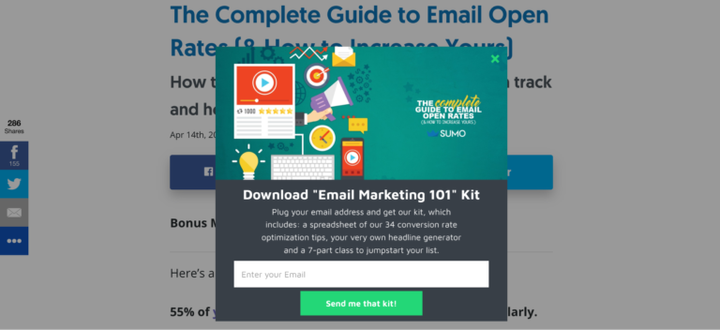
So when is a book the perfect lead magnet?
When you need to earn the trust of your prospective customer, especially if you’re selling something someone complex or nuanced that they don’t fully understand.
For example, if you’re a consultant, coach, or advisor, the nature of your job is that people come to you when they need answers. They have to trust you to know what they don’t.
You see this a lot with branding and marketing.
Business owners know a ton about their product, their financials, and their internal operations, but they don’t have any idea of where to start with branding.
Not only is a book on branding appealing to these people as a way to learn what they don’t know, but hiring a branding agency is a decision totally based on trust. Reading a book written by the CEO of a branding agency is a great way to build that trust, which is exactly why Sol Marketing uses their CEO’s book, Branding Is Sex, as their lead magnet:
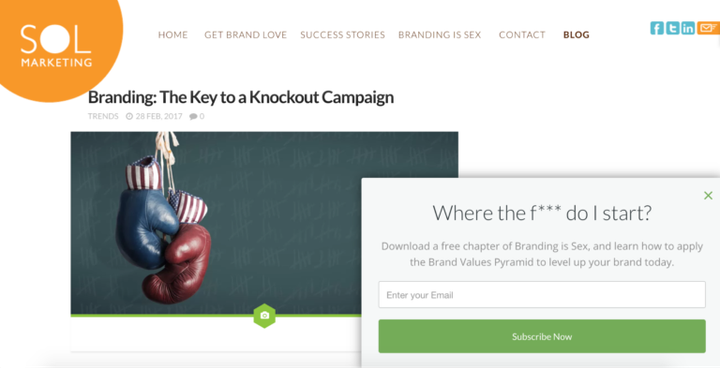
When a prospective customer reads Deb’s book, they no longer feel overwhelmed by how little they know about branding. She has simplified things in a fun, easy-to-understand way, and they have taken an important step forward in fixing their brand.
This is a huge benefit to Deb’s business. She will forever be the person who taught them about branding—the de facto expert on the topic. Which means that when they’re ready to hire an expert, she will be their first choice.
A book positions you as the expert in the field, gives your audience the information they need to feel knowledgeable, and, most importantly, gives you a chance to share the way you approach your work so that those who connect with it can further the relationship.
3 Strategies For Using Your Book As A Lead Magnet
Now, the question is how do you actually use a book as a lead magnet?
There are three main approaches to turning your book into a lead magnet:
- A content-driven approach.
- A social media focused approach.
- A paid advertising approach.
Let’s start with content.
1. Make Your Book An Opt-in on Your Content
This strategy requires more writing on your part, but it is incredibly effective.
The strategy is simple in premise:
- Create content your audience wants to read.
- Embed a form that offers to email them your book.
- Collect emails and build relationships.
I’m not going to go too in-depth on actually creating content—that’s a big enough topic for an entire course—but I will say this:
Your content must target the same people who want to read your book.
If you’re giving away a book on investing, it doesn’t make sense to write reviews of new movies, even if you think it will lead to traffic. No one reading that content will need your book.
The easiest way to set your book up as a lead magnet on your content is to use Sumo.com, a free suite of tools that helps build your email list.
Instead of manually coding a form into your site that offers the book, and then integrating an email platform, you can just use use any of Sumo’s built-in form embeds.
Those embeds includes the little boxes that appear in the corner of your screen as you scroll down a page, like on Sumo’s own blog:
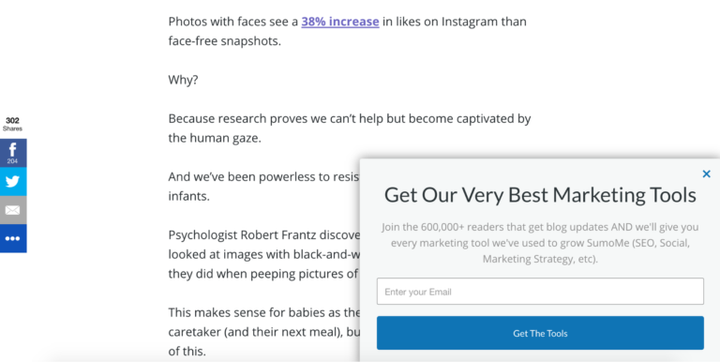
Pop up forms that appear in the center of the page, like on Giftology author John Ruhlin’s blog:
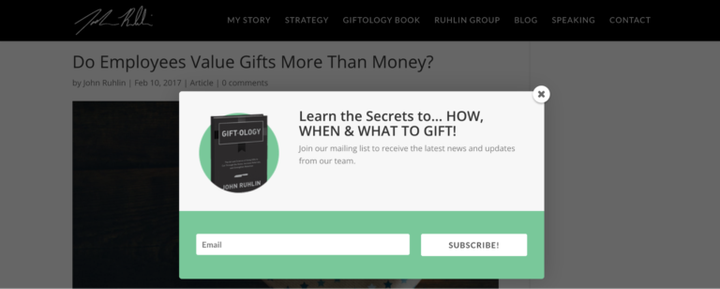
And those full page dropdown forms, like on Finding Success in Failure author Lucas Carlson’s blog:
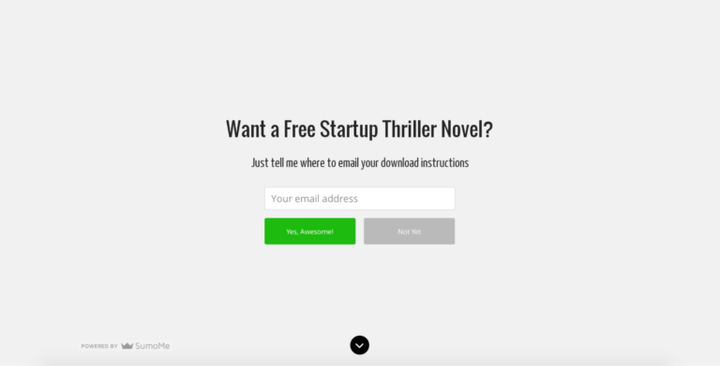
SumoMe will integrate easily with whatever email platform you decide to use, allowing you to start using your book as a lead magnet immediately.
2. Give Free Copies To Your Followers
If you don’t have a blog or don’t want to invest the time in creating content, social media is a great place to engage your audience and offer your book as a lead magnet.
The easiest way to do this is to create a simple landing page for your book and share it on your social media platforms.
Whatever email platform you’re using to store and engage with leads almost certainly has built-in templates for landing pages, and if yours doesn’t, you should consider switching to a platform like ConvertKit.
Just like writing content, designing a landing page is a topic worthy of an entire article, so if you don’t want to use the templates provided by your email platform, I’d suggest using a platform like Unbounce to build your page.
Once you have your page set up, simply share on Facebook and Twitter, and “pin” it to the top of your profiles, like author Geoff Blades:

As you engage new followers, anyone who visits your page will see a link to your landing page, and have the option to sign up for your book.
PRO TIP: You can also use software like Snip.ly to add your own opt-in to links you share on social media, like this New York Times article featuring an opt-in for our book, The Book in a Box Method:

3. Use Paid Traffic To Skyrocket Your Book’s Reach
It’s tricky to make the math work when you’re using paid advertising to sign up leads with a book.
With Google Adwords and Facebook Ads, the two most common pay-per-click advertising platforms, you pay for every person who clicks on your ad.
The cost can stack up quick, and unless those leads those leads are converting at really high rate, you’re essentially losing money to give your book away for free.
However, there is one strategy we see work extremely well for authors: a “Free + Shipping & Handling” ad campaign.
The basic premise is that in your ad, you offer your book for free plus 5 to 8 dollars to cover the cost of shipping and handling. The goal is to have the shipping and handling cost (plus some immediate upsells) cover the cost of the ads, so that you are generating new leads and sharing your book with a wider audience for free.
Once your ads are paying for themselves, you can increase their volume, and send copies of your book to thousands of potential customers.
Ryan Levesque is a great example of this. His bestselling book Ask was run through one of the most successful free + shipping and handling campaigns in history, and is still available:
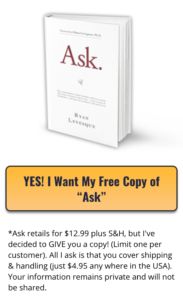
Running this sort of campaign is very involved—if you don’t know anything about PPC advertising, I’d advise against it—but if you want a step-by-step guide to a free + shipping and handling campaign, check out this guide by Ricky Baldasso.
For a Great Lead Magnet, You Need to Write a Great Book
Underlying all of these strategies is the assumption that your book is good enough to convince people to buy from you.
Just “writing a book” isn’t enough for any of these strategies to be effective. What makes them work is the connection they create with prospective customers once they’ve engaged with your ideas.
If you don’t have a book yet, or if your book isn’t good enough, you’re getting ahead of yourself. First, focus on creating an amazing book that will convert leads to customers before you worry about turning it into a lead magnet.
If you’re interested in writing your book yourself, click here to get a free copy of our bestseller The Book in a Box Method. It breaks down our original system for turning the wisdom in your head into a published book using a structured interview process.
If you need some help writing your book, check out our homepage to see we’re a fit to work together.
